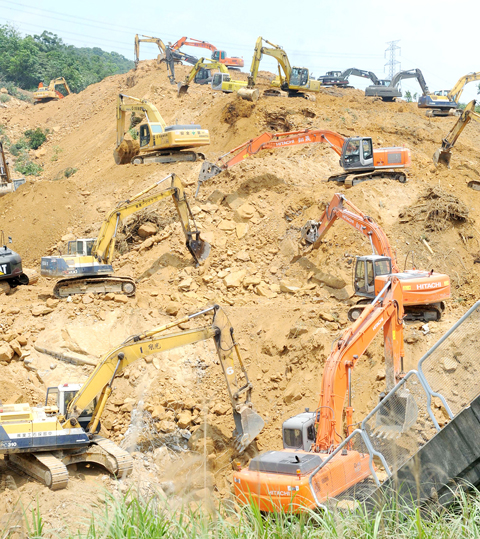About 1,000 workers were mobilized yesterday to remove the piles of earth and rock blocking the Formosa Freeway (Freeway No. 3) following a huge landslide on Sunday, the National Freeway Bureau said yesterday.
National Freeway Bureau chief engineer Lien Shyi-ching (盓鉊昑) said that the bureau was using 59 excavators and 140 gravel trucks for the cleanup.
Lien added that as of 2pm yesterday, the workers had removed 14,174m昆 out of the estimated 200,000m昆 that needs to be removed.

PHOTO: WANG MIN-WEI, TAIPEI TIMES
※Our goal is to increase the number of sites so that more machines and workers can get in. That way, we can work faster,§ Lien said, adding that the bureau is aiming to make the road accessible within two weeks.
Earlier yesterday, the Keelung City Fire Bureau said it had received nine calls from people concerned about missing relatives. It had contacted the owners of seven vehicles suspected of being buried in the landslide, but there are still two cars missing, the bureau said.
Reports of a third car have yet to be confirmed.
As of press time, no people or vehicles had been discovered by the digging crews.
As the landslide occurred on a dip slope, Lien said the bureau had started inspecting all dip slopes along freeways yesterday.
He said they all look fine at the moment, adding that they will invite construction experts and researchers to do a more thorough inspection.
The inspections could also determine the exact reason for the landslide, Lien said.
Lien said that yesterday he did not have the exact numbers of dip slopes along the nation*s freeways, whereas Minister of Transportation and Communications Mao Chi-kuo (椈鶵玿) said in a television interview yesterday that there were 〝approximately 20 in total.
Lien said the freeway was constructed by the National Expressway Engineering Bureau, and the National Freeway Bureau was in charge of maintaining it. Aside from daily inspections, where engineers determine whether there are any visually observable changes on the slopes, Lien said that the National Freeway Bureau also conducts a more detailed inspection every one to two months.
The inspection requires engineers to climb the slopes and observe any changes, he said.
The bureau said the last detailed inspection of the slope that collapsed was on Feb. 1.
Results of that inspection indicated that the ground anchors intended to hold the land were intact, and the diversion ditches were not deformed. Lien said the ground anchors on the slope were not damaged at all after the landslide, adding that the land that slid onto the freeway came from the part of slope that was not anchored during the construction process.
The landslide has caused great disruption to those commuting between Keelung and Taipei after the National Freeway Bureau decided on Sunday night to close both the northbound and southbound lanes north of the Sijhih (鈺糬) Interchange of Freeway No. 3. Traffic congestion was reported yesterday during rush hour between Keelung and Taipei on the Sun Yat-Sen Freeway (Freeway No.1). Between 6am and 9am, the traffic volume increased by 40 percent compared with that on a regular day, the Freeway Bureau said.
The bureau has suggested motorists consider taking alterative routes. Maps of alternative routes are available for download from the bureau*s home page at www.freeway.gov.tw.
To ease the traffic on the Freeway No.1, the National Freeway Bureau decided yesterday that it will open the road shoulders for traffic on the southbound lanes between Sijhih (鈺糬) and Donghu (娵?) from 7am to 7pm daily, starting today.
The Ministry of Transportation and Communications has asked the Taiwan Railway Administration and freeway bus operators to increase services to help transport more passengers.
The 430.5km No. 3 National Freeway was the second North-South freeway built in Taiwan. It begins on Provincial Highway No. 2 near Keelung City and ends on Provincial Highway No. 17 in Pingtung County.
Construction began in 1987 and the first completed section was opened for traffic in 1993. The section affected by the landslide opened in 2000.
ADDITIONAL REPORTING BY CNA

Taiwan is gearing up to celebrate the New Year at events across the country, headlined by the annual countdown and Taipei 101 fireworks display at midnight. Many of the events are to be livesteamed online. See below for lineups and links: Taipei Taipei’s New Year’s Party 2026 is to begin at 7pm and run until 1am, with the theme “Sailing to the Future.” South Korean girl group KARA is headlining the concert at Taipei City Hall Plaza, with additional performances by Amber An (安心亞), Nick Chou (周湯豪), hip-hop trio Nine One One (玖壹壹), Bii (畢書盡), girl group Genblue (幻藍小熊) and more. The festivities are to

Auckland rang in 2026 with a downtown fireworks display launched from New Zealand’s tallest structure, Sky Tower, making it the first major city to greet the new year at a celebration dampened by rain, while crowds in Taipei braved the elements to watch Taipei 101’s display. South Pacific countries are the first to bid farewell to 2025. Clocks struck midnight in Auckland, with a population of 1.7 million, 18 hours before the famous ball was to drop in New York’s Times Square. The five-minute display involved 3,500 fireworks launched from the 240m Sky Tower. Smaller community events were canceled across New Zealand’s

‘IRRESPONSIBLE’: Beijing’s constant disruption of the ‘status quo’ in the Taiwan Strait has damaged peace, stability and security in the Indo-Pacific region, MOFA said The Presidential Office yesterday condemned China’s launch of another military drill around Taiwan, saying such actions are a “unilateral provocation” that destabilizes regional peace and stability. China should immediately stop the irresponsible and provocative actions, Presidential Office spokeswoman Karen Kuo (郭雅慧) said, after the Chinese People’s Liberation Army (PLA) yesterday announced the start of a new round of joint exercises around Taiwan by the army, navy and air force, which it said were approaching “from different directions.” Code-named “Justice Mission 2025,” the exercises would be conducted in the Taiwan Strait and in areas north, southwest, southeast and east of Taiwan

UNDER WAY: The contract for advanced sensor systems would be fulfilled in Florida, and is expected to be completed by June 2031, the Pentagon said Lockheed Martin has been given a contract involving foreign military sales to Taiwan to meet what Washington calls “an urgent operational need” of Taiwan’s air force, the Pentagon said on Wednesday. The contract has a ceiling value of US$328.5 million, with US$157.3 million in foreign military sales funds obligated at the time of award, the Pentagon said in a statement. “This contract provides for the procurement and delivery of 55 Infrared Search and Track Legion Enhanced Sensor Pods, processors, pod containers and processor containers required to meet the urgent operational need of the Taiwan air force,” it said. The contract’s work would be